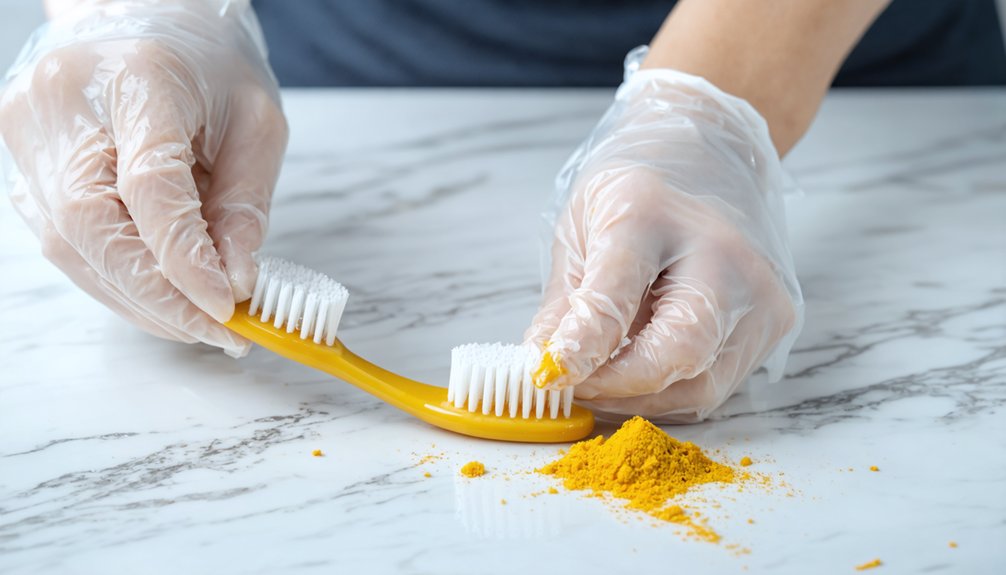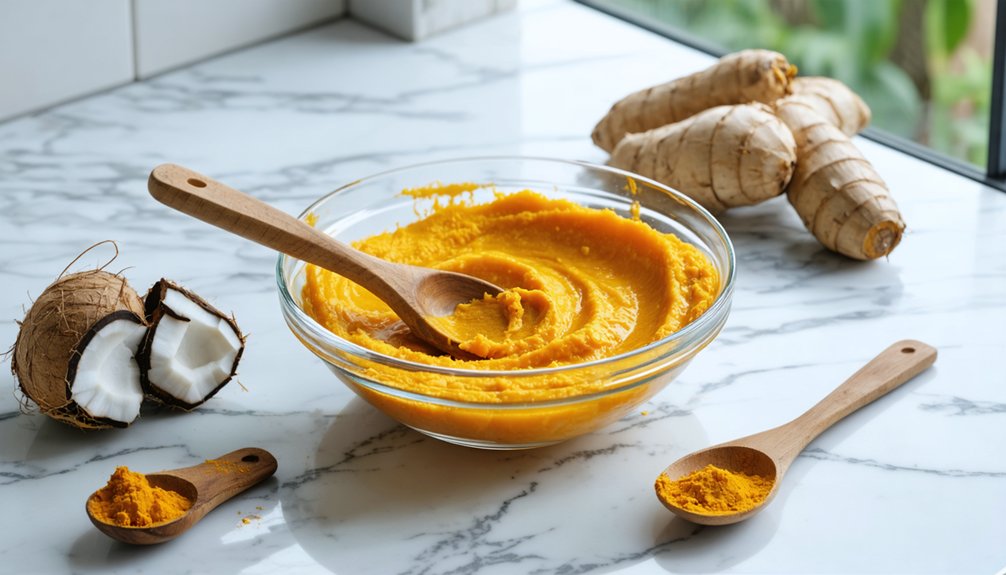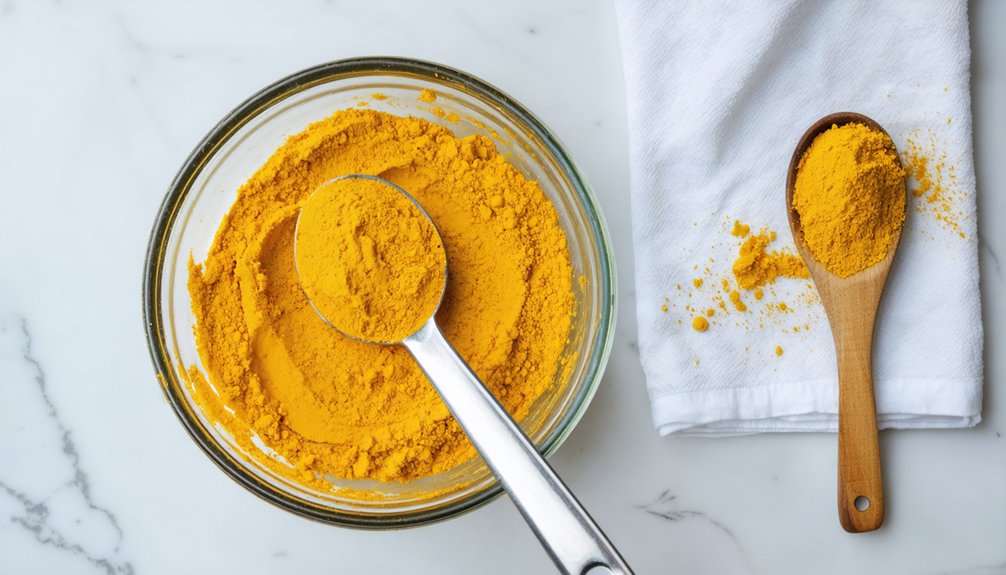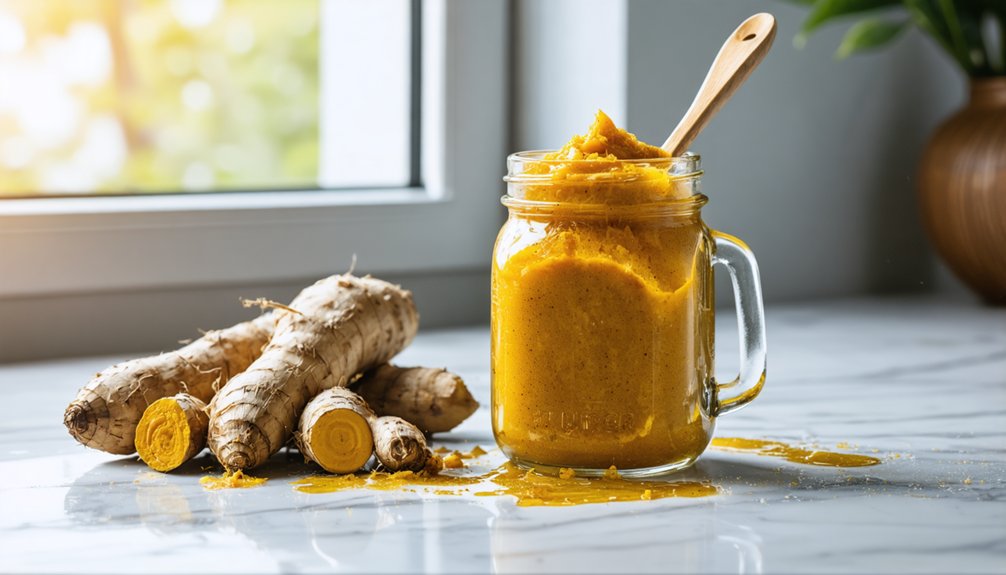You can create a turmeric teeth whitening paste by combining 1/2 teaspoon turmeric powder with 1/2 tablespoon melted coconut oil in a non-metal bowl until smooth. While research shows turmeric’s whitening capabilities are limited, you’ll want to apply the mixture gently to your teeth for 3-5 minutes, then rinse thoroughly. Use a soft-bristled brush and watch for any gum sensitivity. Understanding the science and safety behind this natural remedy will help maximize your results.
Key Takeaways
- Mix 1/2 teaspoon turmeric powder with 1/2 tablespoon melted coconut oil in a non-metal bowl until smooth.
- Add bentonite clay to the mixture for better consistency and teeth-binding properties.
- Optional: Include peppermint essential oil for flavor or baking soda for extra whitening effect.
- Apply paste gently to teeth using a soft brush for 3-5 minutes, then rinse thoroughly with water.
- Store unused mixture in an airtight container and conduct a patch test before first full application.
The Truth About Turmeric and Teeth Whitening
While many social media influencers promote turmeric as a natural teeth whitening solution, scientific evidence suggests the opposite effect. The American Dental Association confirms there’s no scientific support for turmeric’s whitening properties.
Instead, research shows turmeric’s active compound, curcumin, can actually stain your teeth yellow. Professional whitening treatments can brighten teeth six to eight shades in just one hour. Turmeric’s anti-inflammatory properties may help treat gingivitis effectively.
Common turmeric misconceptions stem from DIY recipes that combine turmeric with known whitening agents like baking soda. Any perceived whitening effect typically comes from these other ingredients, not the turmeric itself.
The spice’s impact on enamel includes potential surface roughening, which can affect light reflection and make teeth appear duller.
If you’re seeking natural whitening alternatives, studies show other options like lemon produce better results. However, for safe and effective whitening, professional dental treatments remain your best choice.
Essential Ingredients for Your Natural Paste
Your turmeric teeth whitening paste requires a foundation of turmeric powder, coconut oil, and bentonite clay as core components for maximum effectiveness. The natural ingredients help create stain-removing action while promoting healthier teeth and gums. You’ll enhance the formula by incorporating natural mix-ins like peppermint essential oil for freshness and optional baking soda for extra whitening power. You should store your completed paste in an airtight container in the refrigerator, where it will maintain freshness for approximately one week. The paste should be mixed with non-metal utensils to maintain the clay’s effectiveness.
Core Recipe Components
The essential components of a turmeric teeth whitening paste center on three primary ingredients: turmeric powder, coconut oil, and baking soda.
Turmeric serves as the core whitening agent, while coconut oil acts as a binding ingredient that helps the mixture adhere to your teeth. Baking soda provides gentle abrasive action and helps balance oral pH levels. Unlike conventional whitening products, this natural paste offers safer whitening without risking tooth sensitivity or gum irritation. Adding peppermint extract can help improve the overall flavor profile of the mixture.
For the most effective recipe variations, you’ll want to maintain specific ratios: combine 1/2 teaspoon of turmeric with 1 teaspoon of coconut oil and 1/2 teaspoon of baking soda.
While ingredient substitutions exist in traditional formulations, such as adding salt or mustard oil, it’s best to stick with these three core components. They provide the ideal balance of whitening potential, antimicrobial benefits, and gentle cleaning action.
Natural Mix-In Options
Several natural ingredients can enhance the effectiveness of your turmeric teeth whitening paste beyond its core components.
For antimicrobial additives, consider incorporating mustard oil or salt, which fight bacteria while reducing gum inflammation. You’ll find coconut oil particularly beneficial as it improves paste adhesion and provides antibacterial protection. Regular use of natural turmeric paste helps relieve dental sensitivity and toothache discomfort. The paste should be used once per day to maintain healthy tooth enamel and prevent overuse.
For natural flavoring options, you can add peppermint or clove essential oils to make the paste more palatable while maintaining therapeutic benefits.
If you’re focusing on stain removal, combine baking soda with the turmeric for gentle yet effective surface cleaning.
To support enamel health, consider adding L-arginine or trace minerals, which help maintain proper oral pH balance and strengthen teeth during the whitening process.
Storage and Shelf Life
Proper storage plays an essential role in maintaining the efficacy of your turmeric teeth whitening paste. To maximize shelf life and preserve the active compounds, you’ll need to implement specific storage techniques that protect against degradation.
The paste’s anti-inflammatory properties help promote healthier gums while whitening your teeth naturally.
- Store your paste in an airtight glass container to prevent moisture and avoid chemical leaching.
- Keep the container in your refrigerator, where it will stay fresh for up to 5 days.
- Label your container with the preparation date to track freshness.
- Use clean utensils when scooping out paste to prevent bacterial contamination.
- Check regularly for signs of spoilage, including off-odors, mold, or separation.
Remember to make small batches to guarantee freshness, and always seal the container immediately after use. Mix equal parts coconut oil and baking soda with turmeric powder to create an effective whitening blend.
If you notice any changes in color, texture, or smell, it’s best to discard the paste and prepare a fresh batch.
Step-by-Step Mixing Instructions
Creating an effective turmeric teeth whitening paste requires precise measurements and methodical mixing techniques to achieve ideal results. Begin by measuring your dry ingredients into a clean, non-metal mixing bowl – you’ll need 1/2 teaspoon turmeric powder and optionally 1/4 teaspoon baking soda for gentle abrasion.
Melt your coconut oil if it’s solid, then add 1/2 tablespoon to your dry ingredients. Using a plastic or wooden spoon, blend the ingredients with slow, deliberate strokes until you achieve a uniform consistency. If needed, add water drops sparingly to reach your desired texture. The final paste should be thick enough to cling to your toothbrush without dripping. Transfer your mixture immediately to an airtight container to preserve its potency.
How to Apply the Turmeric Paste Correctly

Successfully applying turmeric teeth whitening paste requires precise timing and gentle technique to maximize its benefits while protecting your enamel.
Using proper application techniques with the right paste consistency will help you achieve superior results while preventing staining and irritation.
- Apply the paste using a soft, damp toothbrush or clean finger, making gentle circular motions on all tooth surfaces.
- Leave the paste on your teeth for 3-5 minutes, avoiding immediate rinsing or brushing.
- Cover both visible teeth surfaces and slightly onto the gums to promote oral health.
- Rinse thoroughly with water after the waiting period, then brush with regular toothpaste.
- Use once daily or 2-3 times weekly, adjusting frequency based on your sensitivity and results.
For enhanced application, consider adding coconut oil or mint extract to improve taste and antibacterial properties.
Safety Precautions and Best Practices
To protect your dental health while using turmeric paste, always monitor your gums for signs of irritation or increased sensitivity.
You’ll need to discontinue use immediately if you experience burning sensations, prolonged discomfort with hot or cold foods, or visible gum inflammation.
Since natural teeth whitening can potentially damage your enamel, it’s essential to maintain gentle brushing techniques and avoid combining turmeric with abrasive ingredients like baking soda or charcoal.
Protect Your Dental Health
While DIY teeth whitening methods may seem appealing, protecting your dental health must remain the top priority when attempting any at-home treatments. Your dental hygiene and enamel protection shouldn’t be compromised for whiter teeth.
Before using any DIY whitening paste, consider these essential precautions:
- Use sensitive toothpaste to minimize discomfort and protect vulnerable teeth
- Avoid sudden temperature changes that can trigger sensitivity during treatment
- Limit exposure time to prevent gum irritation and enamel erosion
- Maintain proper oral care with soft-bristled brushes and non-abrasive toothpaste
- Schedule regular dental check-ups to monitor your enamel health
Monitor for Gum Sensitivity
Monitoring gum sensitivity remains a critical safety component when using any DIY whitening paste. If you notice redness, swelling, or a burning sensation during or after application, immediately discontinue use and rinse thoroughly.
Pay close attention to application timing, never exceeding the recommended duration to prevent chemical burns or tissue damage.
Before starting your whitening regimen, conduct a small patch test to assess your sensitivity risk. During application, use a soft-bristled brush and gentle motions to avoid aggravating your gums.
Watch for white patches or persistent soreness, as these may indicate adverse reactions. If you experience prolonged discomfort or severe gum irritation, consult your dentist.
Consider applying a protective barrier like petroleum jelly to your gums before treatment to minimize direct contact with the whitening ingredients.
What the Research Says About Effectiveness

Although turmeric has gained popularity as a natural teeth whitening remedy, scientific research doesn’t support its effectiveness for this purpose. The scientific limitations of existing studies and reliance on anecdotal claims make it difficult to recommend turmeric for teeth whitening.
Here’s what current research reveals about turmeric’s effectiveness:
- Unlike professional whitening treatments, turmeric doesn’t penetrate tooth enamel to create a whitening effect.
- The American Dental Association hasn’t found evidence supporting turmeric’s whitening properties.
- Turmeric’s pigments may actually stain teeth rather than whiten them.
- Commercial toothpaste performs better for whitening compared to turmeric-based solutions.
- While turmeric offers anti-inflammatory and antimicrobial benefits for oral health, its whitening capabilities remain unproven.
Alternative Natural Whitening Methods
Since many people prefer natural alternatives to commercial teeth whitening products, several evidence-based options exist that may help remove surface stains and brighten your smile.
Among popular natural remedies, oil pulling with coconut or sesame oil for 10-20 minutes daily may improve oral health while gradually lightening teeth. For faster results, you can create a gentle paste using baking soda and hydrogen peroxide, though you’ll want to use this sparingly.
Oil pulling with natural oils offers a gentle path to whiter teeth, while baking soda and peroxide provide quicker – though more intense – whitening results.
In your teeth care routine, activated charcoal applied twice weekly can help absorb surface stains, but be careful not to scrub too vigorously.
While fruit-based treatments like strawberry-baking soda paste or citrus peels might seem appealing, use these cautiously as their acids can damage enamel.
These natural methods typically require consistent use for subtle improvements.
Potential Side Effects and Staining Risks

While turmeric offers potential teeth whitening benefits, it carries several notable risks that require careful consideration. For effective staining prevention and proper enamel care, you’ll need to be aware of these key concerns:
- Turmeric can cause yellow-orange discoloration on teeth, gums, and dental work if not rinsed properly after use.
- Aggressive application may lead to enamel erosion, increasing tooth sensitivity and decay risk.
- Some users experience gum irritation or burning sensations, particularly those with sensitive oral tissues.
- Dental restorations like veneers and bonding can become stained, compromising their aesthetic appearance.
- Powder form can easily stain countertops and clothing, requiring immediate cleanup to prevent permanent marks.
To minimize these risks, limit applications to once daily and always use gentle motions when applying the paste.
Tips for Maintaining Oral Health While Using Turmeric
Understanding proper oral care techniques can help you maximize turmeric’s benefits while protecting your dental health. While incorporating turmeric into your oral hygiene routine, continue using fluoride toothpaste as your primary cleanser and maintain daily flossing habits.
Don’t skip regular dental check-ups, as professional monitoring guarantees you’re safely receiving turmeric benefits.
Keep your routine balanced by brushing with turmeric only once daily to minimize abrasive exposure. After applying turmeric paste, rinse thoroughly and follow with regular toothpaste.
Store your turmeric mixture in an airtight container, and never dip your toothbrush directly into the powder. To enhance effectiveness, combine turmeric with coconut oil and consider adding mint extract to improve taste.
Remember to stay hydrated and maintain a low-sugar diet to support overall oral health.
Frequently Asked Questions
Can I Use Fresh Turmeric Root Instead of Powder for the Teeth Whitening Paste?
Like many DIY enthusiasts, you’ll find fresh turmeric’s benefits are limited for teeth whitening. While you can use it, powder’s more concentrated formula and consistent texture makes turmeric paste effectiveness markedly better.
How Long Should I Wait Between Brushing With Regular Toothpaste and Turmeric Paste?
You don’t need to wait between pastes – just rinse thoroughly in between. For ideal oral hygiene timing tips, you can brush with either paste first, then rinse well before using the other.
Will Turmeric Stains on My Toothbrush Affect Future Regular Brushing Sessions?
Don’t worry – turmeric stains won’t affect your regular brushing sessions. For proper toothbrush maintenance, rinse thoroughly with hot water and consider using baking soda paste for stubborn stain removal tips.
Can I Combine Turmeric Paste With Commercial Whitening Products for Better Results?
Don’t combine turmeric paste with commercial whitening products. While turmeric has oral health benefits, there’s no evidence for enhanced whitening effectiveness, and the mixture could reduce whitening results or damage your teeth.
Should I Brush My Tongue While Using the Turmeric Paste Mixture?
Yes, you should brush your tongue using gentle, forward-sweeping motions for complete oral hygiene. This removes bacteria that could recolonize your teeth and guarantees your brushing techniques maximize turmeric paste’s benefits.
References
- https://www.stonestreetdental.com/blog/can-turmeric-really-whiten-teeth/
- https://pmc.ncbi.nlm.nih.gov/articles/PMC9645194/
- https://grandcentraldentistry.com/turmeric-teeth-whitening-does-it-really-work/
- https://www.smileyfamilydentistry.com/blog/can-turmeric-be-used-as-teeth-whitening/
- https://pmc.ncbi.nlm.nih.gov/articles/PMC10024105/
- https://www.urmc.rochester.edu/news/publications/health-matters/diy-teeth-whitening-too-good-to-be-true
- https://www.bricedental.com/blog/2024/07/18/can-i-really-whiten-my-teeth-with-turmeric/
- https://www.colgate.com/en-us/oral-health/teeth-whitening/turmeric-for-teeth-will-a-spice-whiten-your-smile
- https://www.wdentalfresno.com/blog/2025/06/14/turmeric-for-teeth-whitening/
- https://adanews.ada.org/huddles/dentists-urge-against-viral-turmeric-coconut-oil-tooth-whitening-trend/



